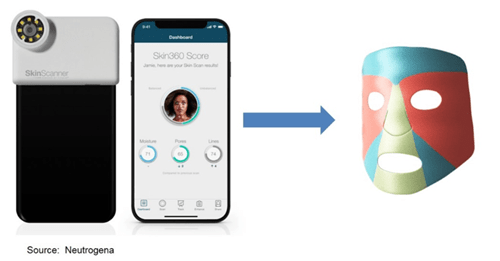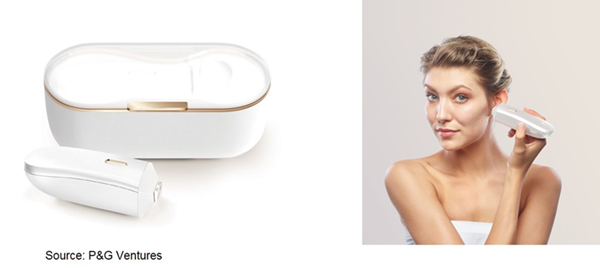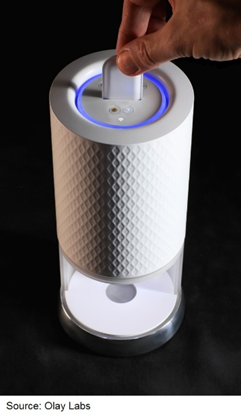“Magic mirror on the wall, who is the fairest one of all?” These days just look to your augmented reality mirror to get all the answers and more!
CES never disappoints in showcasing new, cool (and even ridiculous) technology, but for 2019 there was more tech related to beauty – including artificial intelligence, virtual reality, 360-degree video capture, facial recognition, and even 3-D printing – than ever before.
With a global cosmetics market expected to grow to $863 billion by 2023 from $532 billion in 20171. it’s no surprise that cosmetic companies are investing in new technology to develop solutions that will help both men and women retain youthful appearances.
From augmented-reality mirrors to 3D-print custom face masks to adhesive skin sensors that track skin pH in real-time to thermal inkjet printers for your skin, beauty companies are showing off beauty solutions of the future that offer in-depth, personalized skincare analysis based on the evolving conditions of the skin, local weather and more, while keeping an ongoing record of users’ skin to track skincare progress.
AR and AI finding their way into the beauty industry
In many ways, AR and AI in the beauty industry should be no real surprise. Watching any sci-fi movie or TV series over the last 50 years has always illustrated the possibilities. Think about Total Recall, where the receptionist can change her nail color with the tap of a wand. Or how about the Jetsons or Star Trek, where an AR mirror can show them with different looks. Or what about the magic wands that they can swipe across their face to put on makeup.
These are just a few examples of what is actually happening today.
Mirror, mirror on the wall …
A variety of companies have introduced augmented reality mirrors that allow customers to try on a makeup, different hair colors and even offer skin diagnosis. Using facial recognition technology, these AR mirrors offer 360-degree video capture to view a customer’s face/hair from every angle. In addition, these AR mirrors can be enabled to retrieve customers’ past looks and services.
The beauty of AI
Leveraging both artificial intelligence and deep-learning technologies, companies are introducing solutions that provide customers with a smart skin analysis and personalized product recommendations based on just a selfie and a short questionnaire.
For instance, Procter & Gamble’s online Skin Advisor tool tells users how old their skin looks. This “Future You Simulation” uses an algorithm to show users what their skin and face will look like in the future under different scenarios, such as not wearing sunscreen regularly. This falls into “the good, the bad and the ugly” category.

Neutrogena MaskiD
Johnson & Johnson’s Neutrogena introduced its MaskiD, a device that users can attach to their phones to analyze their faces. The device measures the size of a user's face and then, using 3D printing technology, creates a custom mask to fit, along with targeted treatments. Each mask has a unique shape and color patterns for different skin needs. And it could also double as a Halloween mask …

Olay Smart Wand
The Olay Smart Wand in conjunction with its Skin Advisor mobile app, promises to "personalize and optimize" skincare products to a user's specific skin problems. The Smart Wand receives information and instructions from the mobile app to create temporary, dynamically programmable fields that drive individual ingredients into the skin, targeting the consumer's specific skin issues.
On a side note, Olay might want to rethink the name of this device, as a simple Google search on Smart Wand leads you to an array of personal pleasure devices …
My Skin Track pH

L'Oréal unveiled a wearable adhesive skin sensor that tracks skin pH in real-time to create customized product regimens to better care for skin.
The device, My Skin Track pH, is a small, thin, flexible sensor to measure individual skin pH levels using microfluidic technology. It captures trace amounts of sweat from skin pores through a network of micro-channels, providing an accurate pH reading within 15 minutes.
Opté – an eraser for your skin
Procter & Gamble’s startup studio P&G Ventures launched Opté Precision Skincare that combines an LED scanner, camera, minicomputer and micro-printer in one device. Opté scans the skin for any hyperpigmentation and then applies a corrective serum to reveal the natural beauty of the skin.

The device uses a technology called microfluidics, which essentially is the science of manipulating and controlling fluids, normally in the range of microliters.
The on-board camera captures 200 skin images per second; producing approximately 24,000 skin images to be analyzed. The micro printer has 120 thermal inkjet nozzles and deposits 1,000 optimizing serum picoliter droplets, which is one billionth of a liter.
In short, the device offers a non-surgical, laser-free skincare treatment with the ability to erase dark spots or other imperfections – I could get behind this product!
Olay Labs Moments: The Keurig® of skincare
Of all of the great beauty tech that was shown at CES – the Olay Labs Moments definitely proved to be something out of the future … except that the future is now.

Providing truly personalized skincare, the Olay Labs Moments will offer real-time, in-home, on-demand, custom-blended skincare products, created daily for both daytime and nighttime regimens. Combining the power of machine learning with human expertise, Olay Labs Moments offers consumers a tailored, four-week skincare regimen. At the heart of the system is an algorithm that boasts the ability to learn and adapt to a user's individual needs in real-time and provide advice as needed.
You simply insert a pod of a base material into the unit; then based on your personalized skincare needs and environmental surroundings, the tower will print custom lotions for your daytime and nighttime routines – all in the correct amounts.
Final thoughts
It was fascinating to see the integration of advanced technologies find its way into the beauty industry. But perhaps more important, it proves to be another valuable use case for artificial intelligence. Instead of wasting money on products that don’t work, the use of AI and machine learning can help consumers navigate through the thousands of products on the market to find solutions that are personalized and customized to their individual needs.
Magic mirror on the wall …
1 OrbisResearch.com
